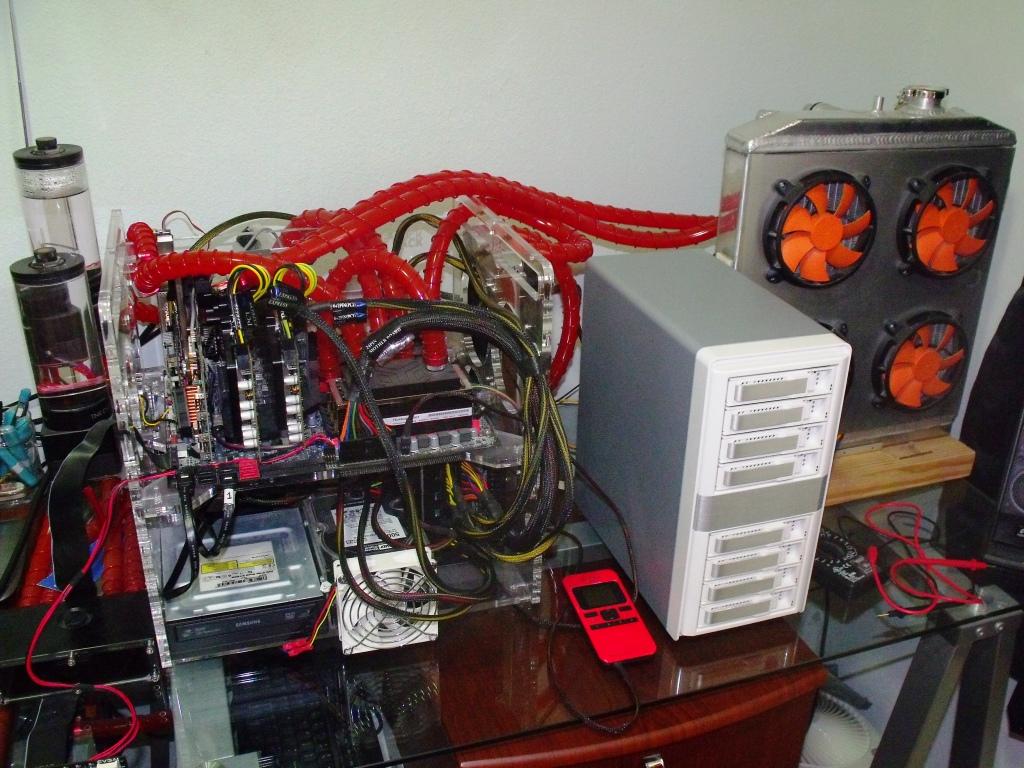 This is the Test Bench and a quick click will display it close up. As you may have guessed, it truly is no ordinary Test Bench, and I have dedicated many many hours creating this build, which has been used in many benchmarking excursions and extreme overclocking sessions. She has even set a few HWBot world records along the way!
This is the Test Bench and a quick click will display it close up. As you may have guessed, it truly is no ordinary Test Bench, and I have dedicated many many hours creating this build, which has been used in many benchmarking excursions and extreme overclocking sessions. She has even set a few HWBot world records along the way!
Our main focal point in this report will be an array of 4 Samsung SpinPoint F4EG (HD204UI) 2TB hard drives that Samsung has graciously provided for testing purpose, and the 2 C300 256 GB SSDs.
SYSTEM CONFIGURATION:
CPU: Intel i7-920 DO @ 4.46 Ghz
MOTHERBOARD: EVGA E760 Classified Motherboard
RAM: 6 GB watercooled Crucial Dominators 2000MHz CL8 kit. 7-8-7-24@1700
GPU: Dual EVGA GTX480
POWER: ST1500 Fully Modular 1500 Watt Power Supply 1500W (Peak 1600W) 12v1320W/110A (Peak 120A)combined+3.3 5v 280W
CHASSIS: Danger Den Torture Rack
CPU COOLER: HeatKiller 3.0
WATER SYSTEM: Two KMP-400 w/reservoirs in a Parallel loop with Bitspower reservoir , two MCR320-QP rads, and 1 BIPS 240 rad. Areca 1880IX-12, EK Ram Block, EK Fullboard Mobo Block on Loop 1. Loop 2- CPU only. Loop 3- MCP-655 and Honda Radiator on dual GPUs.
STORAGE: 4 Samsung SpinPoint F4EG (HD204UI), and 2 C300 256 GB SSDs
ENCLOSURE: ARC-4036 6gb/s JBOD, provided by Areca for our test bench.
TEST PROTOCOL
Our F4EGs will be placed in a RAID-0 configuration and this is mainly to illuminate the performance of the array as a standalone unit, then with the CacheCade acceleration. Our Hard Disk Drives that we are using are low power 5400 rpm drives, so the acceleration of the array is going to be markedly more dramatic than shown in some marketing materials. As always, your results will depend upon your specific equipment and configuration, and weigh heavily upon the performance of your SSDs. CacheCade is a complex upgrade, and those in the enterprise field already know that any large projects should be designed and administered by a storage professional.
BENCHMARK SOFTWARE
Software used for testing for this review will consist entirely of Iometer runs.
The base array consists of 4 Samsung F4EG drives configured in raid 0, stripe size of 64KB. Then the SSD were configured into a CahceCade volume through a very easy-to-use wizard that is present on the main page of the MegaRaid Storage Manager. The MSM is a GUI that allows control of the RAID card from within the operating system, and is very functional and easy to use.
Controller Settings
Disk cache policy: Disable
Read Policy: No Read Ahead
I/O policy: Cached I/O
Write Policy: Write Back
In order to decouple the HDD array from the CacheCade volume, the Write Policy is simply changed to Write Through.
Well, let’s get on with the benchmarks already!
NEXT: Single Zone Read
Page 1- Introduction
Page 2- Nuts and Bolts
Page 3- Maximizing Benefits
Page 4- MLC vs SLC
Page 5- Test Bench and Protocol
Page 6- Single Zone Read
Page 7- Hot-Warm-Cool-Cold
Page 8- Conclusion
 The SSD Review The Worlds Dedicated SSD Education and Review Resource |
The SSD Review The Worlds Dedicated SSD Education and Review Resource | 
Very helpful analysis, thank you very much!